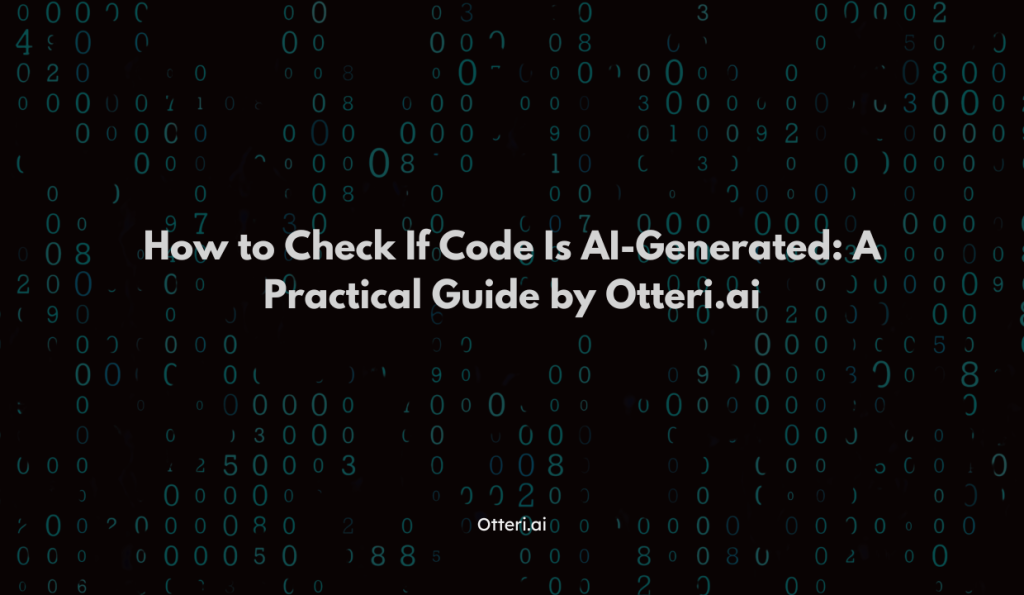
As artificial intelligence (AI) tools like ChatGPT, GitHub Copilot, and other code generators become more common, many developers, educators, and hiring managers are beginning to wonder: can you tell if AI or a human wrote code? Whether you’re reviewing code for educational purposes, recruitment, or security, knowing how to detect AI-generated code is becoming an essential skill.
At Otteri.ai, we are committed to helping users navigate the evolving role of AI in software development. In this guide, we explore how to recognize AI-generated code, useful tools to help you, and practical ways to verify code authenticity.
Why Knowing the Origin of Code Matters
In today’s digital world, identifying AI-generated code is important for several reasons. In education, instructors need to ensure students are genuinely learning and not relying solely on AI tools. In hiring, recruiters must evaluate actual coding skills rather than just the ability to prompt an AI system. For security and compliance, AI-generated code may carry unknown vulnerabilities or licensing issues that could impact your organization.
Understanding the source of code helps maintain quality, accountability, and trust across various industries.
Signs the Code May Be AI-Generated
AI-generated code often follows specific patterns, making it different from code written by human developers. One of the most common signs is a repetitive or generic structure. AI tools tend to use standard patterns and naming conventions, which can make the code appear uniform and lacking in personal style.
Another tell-tale sign is over-commenting. AI often includes detailed comments, even for very basic code. For example, adding an explanation for a simple addition function is something a human coder is unlikely to do.
In some cases, AI tools may add unnecessary complexity to simple problems. Instead of writing concise, efficient code, AI might include redundant steps or verbose logic. This over-engineered approach can be a strong indicator of AI involvement.
Additionally, AI-generated code lacks the unique touch or creativity that many developers bring to their work. Human coders often have personal preferences for variable names, formatting styles, or problem-solving approaches. AI code tends to feel impersonal and “too perfect” or overly clean.
Useful Tools for Detection
There are several tools that can help identify whether code is AI-generated. Some general AI detectors, originally designed for essays, can also analyze code. Tools like GPTZero or AI Detector Pro assess textual patterns, although their accuracy for code is not always consistent.
Specialized platforms, such as Moss (developed by Stanford) or Codequiry, are more focused on detecting code plagiarism and similarities. These can help identify if code closely matches publicly available examples or known AI-generated patterns.
Emerging technologies are also working on detecting AI-generated code more accurately. For example, GitHub is exploring ways to detect code that originates from Copilot. These tools are still in development but represent the future of AI detection in coding environments.
Practical Methods to Verify Code Authorship
While tools are useful, manual verification remains one of the most effective approaches. Asking the developer to explain their code can quickly reveal whether they genuinely understand the logic. If someone struggles to describe how their code works, it could indicate that it was not self-written.
Another method is to request small changes or optimizations. A true author will be able to adjust or improve the code with ease. If they hesitate or cannot modify it efficiently, that might be a red flag.
Searching code snippets online is also a helpful technique. Since AI tools often pull from public forums like Stack Overflow, you can sometimes find matching examples by doing a simple search. This can provide insight into whether the code is original or generated.
AI Detection: Not Always Perfect
It’s important to acknowledge that detecting AI-generated code is not always straightforward. Skilled users may edit AI-generated code to appear more human, while beginner programmers might write code that unintentionally resembles AI output. No single method offers guaranteed accuracy.
Combining tools, manual checks, and understanding the context in which the code was written provides the best results. A balanced approach helps ensure fairness and accuracy when evaluating code.
The Future of Code Detection
As AI becomes more integrated into development workflows, distinguishing between human and AI-generated code will become more challenging. Future detection tools may utilize code fingerprinting, behavioral analysis, and machine learning models specifically trained to spot AI-generated code.
At Otteri.ai, we are committed to staying ahead of these trends by offering advanced solutions that help users detect and analyze AI-generated content effectively.
Final Thoughts
Detecting AI-generated code is no longer just a theoretical concern—it’s a practical need in today’s tech landscape. By recognizing patterns such as repetitive structures, over-commenting, and lack of personal style, you can start to distinguish AI code from human-written code.
Using a combination of detection tools and manual verification, you can make informed decisions and ensure code integrity in any environment. Otteri.ai is here to support you with the insights and tools you need to navigate the rise of AI in software development.
Stay informed with the latest developments in AI, code analysis, and detection technology. Subscribe to Otteri.ai for expert guides, innovative tools, and updates that help you stay one step ahead in AI-driven development.